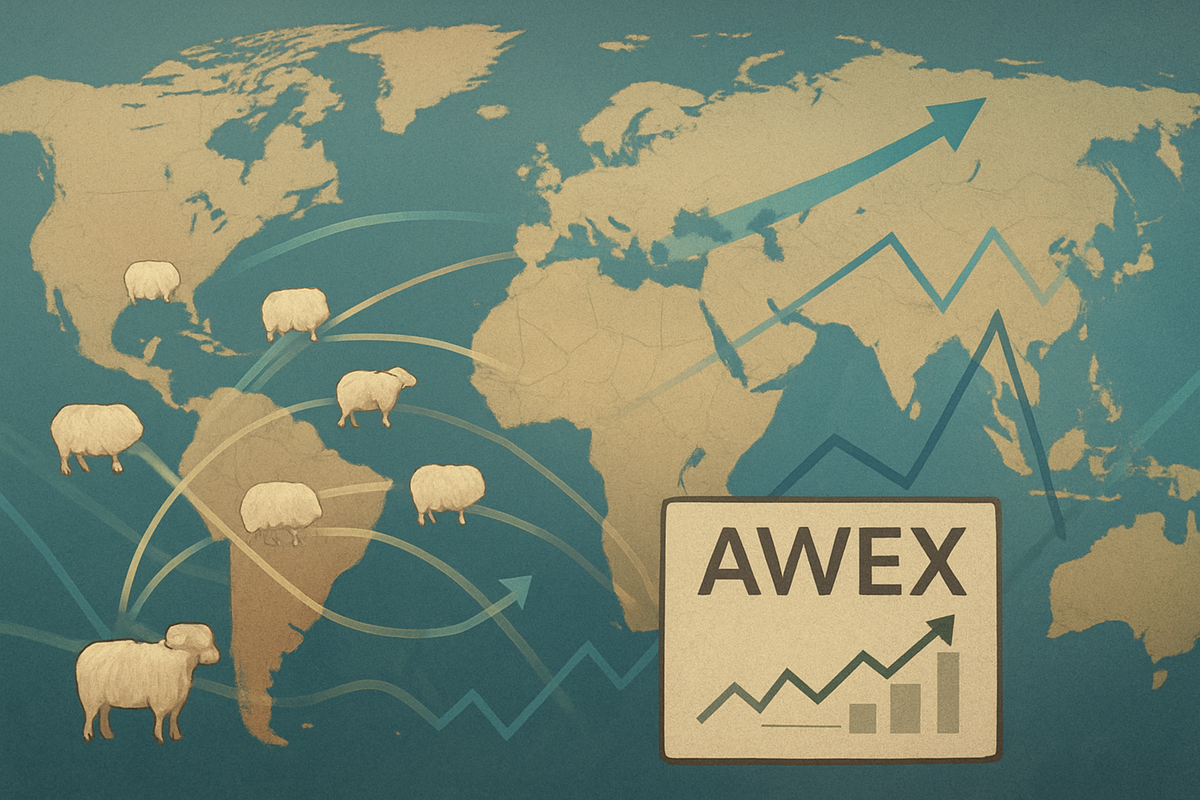
The Australian Wool Exchange (AWEX) stands as an indispensable pillar in the global wool commodity market, with its comprehensive price reporting, particularly the Eastern Market Indicator (EMI), serving as the world's primary benchmark for wool pricing. This crucial role means that fluctuations in AWEX reports have immediate and profound implications for an intricate web of market participants, from sheep farmers in the Australian outback to textile manufacturers across Asia and Europe. The EMI, a composite indicator reflecting the overall movement of Australia's vast wool market, offers a transparent and centralized view into the complex interplay of supply, demand, exchange rates, and trade policies that dictate global wool values.
As of November 28, 2025, the ongoing relevance of AWEX's reporting continues to shape strategic decisions throughout the wool supply chain. Its daily and weekly updates provide real-time intelligence that informs everything from a grower's decision on when to sell their clip to a processor's procurement strategy. The EMI's direct reflection of global demand and pricing trends makes it a critical tool for risk management, investment planning, and understanding the broader economic health of the textile industry, especially as external factors exert increasing pressure on commodity markets.
The Pulse of the Fleece: Dissecting AWEX's Market Mechanics
AWEX's influence stems from its meticulous data collection and the subsequent generation of the Eastern Market Indicator (EMI), a benchmark introduced in 1979 that has since become the gold standard for Australian greasy wool prices. This indicator is not merely a simple average but a weighted composite reflecting a broad spectrum of wool types, including Merino and non-Merino fleece wool, skirtings, and cardings. The data is rigorously collected from every lot sold at Australia's major wool auctions, which remain the dominant method of trading wool in the country. This comprehensive approach ensures that the EMI provides a robust and representative snapshot of market conditions.
The timeline of AWEX reporting is continuous, with daily updates reflecting auction outcomes and weekly summaries providing deeper analysis. This consistent flow of information is vital for market transparency. Key players involved include thousands of Australian wool producers, who rely on AWEX for fair price discovery; international wool buyers and traders, who use the EMI as a basis for their purchasing and selling strategies; and global textile manufacturers, who monitor the indicator to gauge raw material costs and demand trends. Initial market reactions to significant EMI movements are often swift, with futures markets adjusting accordingly and industry analysts providing immediate commentary on the drivers behind the shifts, whether they be currency fluctuations, changes in global economic sentiment, or shifts in consumer demand for natural fibers.
Beyond the raw numbers, AWEX reports also provide critical analysis on the factors influencing prices. For instance, the Australian dollar's (AUD) exchange rate against major currencies like the US dollar (USD) or the Euro (EUR) is a perpetual focus. A stronger AUD can make Australian wool more expensive for international buyers, potentially dampening demand and putting downward pressure on the EMI, while a weaker AUD can have the opposite effect. Similarly, shifts in global trade policies, such as tariffs imposed by major consuming nations like China or changes in free trade agreements, can significantly alter the competitive landscape for Australian wool, directly impacting prices reported by AWEX. The detailed reports from AWEX often highlight these macroeconomic and geopolitical factors, providing context for the observed price movements.
Furthermore, the fundamental forces of supply and demand are always at play. AWEX monitors and reports on factors affecting supply, such as seasonal conditions in Australia that impact flock numbers and wool quality, as well as global wool production trends from other major producers like New Zealand or South Africa. On the demand side, indicators of economic growth in key consumer markets, evolving fashion trends towards natural fibers, and the performance of the global textile industry are all critical. AWEX's ability to synthesize these diverse inputs into a coherent price signal makes it an invaluable resource for all stakeholders seeking to navigate the often-volatile global wool market.
Corporate Fortunes in Flux: Winners and Losers in the Wool Market
The intricate dance of AWEX wool prices, exchange rates, trade policies, and supply/demand dynamics creates a volatile landscape where public companies across the global wool supply chain can find their fortunes shifting dramatically. Identifying pure-play public wool production companies is challenging, as many are private or part of larger agricultural entities. However, publicly traded processors and retailers are directly exposed to these market forces.
On the processing front, companies like Xinao Textiles Inc. (SHE: 002298), a Chinese manufacturer of wool tops and worsted yarn, are highly sensitive to AWEX price movements. When the AWEX EMI rises, their raw material costs increase, potentially squeezing profit margins if they cannot effectively pass these costs onto their customers. Conversely, a decline in the EMI offers a significant advantage, reducing input costs and potentially boosting profitability or allowing for more competitive pricing. Similarly, Indorama Ventures Public Company Limited (BKK: IVL), a diversified chemical company with a growing presence in worsted yarn, would see its yarn segment's profitability influenced by these raw material price shifts.
For luxury retailers and apparel brands, the impact is also substantial. Companies such as Ralph Lauren Corporation (NYSE: RL), which uses wool extensively in its premium labels, and high-end brands like Ermenegildo Zegna (NYSE: ZGN), known for their exquisite wool fabrics sourced from Australian Merino, face increased sourcing costs when AWEX prices are high. A stronger Australian dollar (AUD) further exacerbates this, making their AUD-denominated wool purchases more expensive in their local currencies. Conversely, a weaker AUD coupled with stable or falling AWEX prices can significantly reduce their cost of goods, enhancing margins and potentially allowing for more aggressive pricing strategies or increased investment in wool-based collections.
Trade policies, such as tariffs, also create distinct winners and losers. For example, if tariffs are imposed on processed wool products entering a major market, a Chinese processor like Xinao Textiles Inc. could see its export competitiveness severely hampered, leading to reduced sales and profitability. Conversely, domestic textile manufacturers in the importing country might benefit from reduced foreign competition. The ongoing negotiation and implementation of Free Trade Agreements (FTAs) can similarly reshape market access and cost structures, providing advantages to companies operating within the beneficiary nations while potentially disadvantaging those outside these agreements. Ultimately, companies with diversified sourcing strategies, robust supply chain management, and the ability to adapt to fluctuating input costs and trade environments are best positioned to navigate the inherent volatility of the global wool commodity market.
Broader Currents: Sustainability, Policy, and Historical Echoes
The importance of AWEX wool price reporting transcends mere transactional data; it is deeply embedded within broader industry trends, significantly impacts competitors and partners, carries substantial regulatory implications, and echoes lessons from a rich historical tapestry. As of November 28, 2025, the AWEX Eastern Market Indicator (EMI) continues to be the definitive global benchmark, its movements reflecting and influencing critical shifts across the entire wool ecosystem.
A paramount trend is the industry's intensifying focus on sustainability and ethical practices. AWEX is actively championing the Australian Wool Sustainability Scheme (AWSS), positioning it as the preferred certification framework for Australian greasy wool from farm to scour. This scheme, leveraging digital traceability tools like WoolClip and eBale, is not merely a marketing gimmick but a necessity for maintaining access to premium global markets and meeting the escalating consumer demand for environmentally responsible and ethically sourced natural fibers. The National Wool Declaration (NWD), which provides crucial data on mulesing status, remains a critical component, enabling buyers to make informed decisions in a market increasingly sensitive to animal welfare concerns. Premiums for certified wool, such as RWS-accredited non-mulesed Merino fleece, underscore the market's tangible valuation of these sustainable practices, signaling a long-term shift in purchasing priorities.
The ripple effects of AWEX's reporting are felt globally. Wool-producing nations like New Zealand and Uruguay closely monitor the EMI as a primary reference point for their own wool pricing, demonstrating its pervasive influence on international trade. Fluctuations in the EMI, driven by global economic conditions and demand from major economies like China, directly shape purchasing strategies for wool buyers and processors worldwide. Furthermore, the Australian dollar's exchange rate against major currencies acts as a critical lever; a weaker AUD makes Australian wool more attractive to foreign buyers, potentially boosting demand and influencing the EMI, thereby affecting the competitiveness of other wool-producing regions. Enhanced supply chain transparency through AWEX's digital initiatives also fosters stronger partnerships by reducing risks and streamlining transactions.
Regulatory and policy implications are equally significant. AWEX's role in setting and maintaining industry standards for clip preparation is vital for upholding the quality and integrity of the Australian wool clip. The NWD and its Integrity Program are crucial for compliance with evolving global animal welfare standards, with local regulations (e.g., Victoria's mandate for pain relief during mulesing) directly impacting declaration practices and market access. The AWSS aligns with broader national frameworks like the Sheep Sustainability Framework, reinforcing Australia's commitment to sustainable production and potentially influencing future agricultural and trade policies. Major economies also monitor the EMI as an indicator of global demand, which can indirectly inform their broader economic and trade policies.
Historically, the wool market has been characterized by dramatic boom-and-bust cycles. The collapse of the Australian Wool Reserve Price Scheme (RPS) in 1991, which attempted to stabilize prices but ultimately failed due to massive oversupply, serves as a stark reminder of the dangers of market intervention and the inherent volatility of commodity markets. The EMI itself was introduced during the RPS's operation in 1979, providing a continuous, market-driven price signal. Post-war booms and busts, such as the Korean War-driven price surge in the 1950s, further illustrate how geopolitical events can profoundly impact wool values. These historical precedents emphasize the need for transparency, adaptability, and a deep understanding of market fundamentals—qualities that AWEX's reporting system aims to provide—to navigate the complexities of the global wool trade.
The Road Ahead: Navigating Future Trends and Challenges
The global wool market, continuously charted by AWEX's comprehensive reporting, stands at a pivotal juncture as of November 28, 2025. Both short-term volatility and long-term transformative trends are shaping its trajectory, demanding strategic pivots and adaptive measures from all stakeholders.
In the short term (the next 1-2 years), the market anticipates continued growth, albeit with inherent price fluctuations. The AWEX EMI has demonstrated robust performance over the past year, with significant year-on-year gains across various wool types, signaling strong demand and a tightening Australian supply. However, immediate challenges persist, including price volatility driven by supply-demand imbalances, currency movements, and weather patterns. A recent oversupply of fine Merino wool has temporarily reduced premiums in that segment, though crossbred wools and other Merino types are finding support as overall supply eases. Encouragingly, improving economic signals from China, a dominant market participant, are providing a foundational boost to demand.
Looking further ahead (5+ years), the long-term outlook for the global wool market remains moderately optimistic. Projections suggest consistent growth, fueled primarily by a powerful global shift towards sustainable fashion and natural fibers. Consumers are increasingly favoring eco-friendly, biodegradable materials like wool over synthetic alternatives, creating a sustained demand for traceable and ethically produced wool. This trend is coupled with technological advancements in wool processing, production efficiency, and the expansion of wool into innovative applications beyond traditional apparel, such as home textiles, industrial uses, and building insulation. Rising disposable incomes in emerging economies, particularly across the Asia-Pacific region, are also expected to drive increased consumption and manufacturing capabilities.
To capitalize on these opportunities and mitigate emerging challenges, strategic adaptations are imperative. The industry must prioritize enhanced traceability and transparency, leveraging platforms like WoolClip and eBale, and potentially blockchain technology, to provide immutable records from farm to product. This builds consumer trust and meets demand for provenance. Continuous promotion of sustainable production practices and certifications, such as the Australian Wool Sustainability Scheme (AWSS) and Responsible Wool Standard (RWS), is crucial to position wool as the "world's premium sustainable fiber." Investment in research and development for new wool blends and innovative applications will expand wool's versatility, while proactive strategies are needed to address climate change impacts on production. Strengthening supply chains and improving market communication will also be vital for efficiency and stakeholder engagement.
However, significant challenges loom. Persistent competition from synthetic fibers, which often offer cost advantages and versatility, remains a constant threat. Price volatility, influenced by global economic conditions, exchange rates, and agricultural factors, will continue to create uncertainty. Declining global sheep populations and raw material access, driven by urbanization and changing agricultural practices, could lead to supply disruptions. Climate change, with its potential for prolonged droughts, altered rainfall patterns, and increased pests, poses a direct threat to wool production and quality. Ethical and animal welfare concerns, amplified by public scrutiny, can also shape consumer perceptions. Geopolitical and economic instability could further dampen consumer spending on luxury wool products.
Considering these factors, several scenarios could unfold. An optimistic scenario sees a "Sustainable Wool Renaissance," where strong consumer demand for ethical products, coupled with technological innovation and robust traceability systems like AWEX's AWSS, drives significant growth and premium pricing for certified wool. Industry collaboration ensures highly efficient and resilient supply chains. A moderate scenario depicts "Adaptive Evolution," with steady but modest growth, where the industry successfully navigates challenges by slowly adopting new technologies and certifications, maintaining its niche despite persistent synthetic competition. In a more pessimistic scenario, "Stagnation and Niche Market Contraction," the market faces significant headwinds from unresolved animal welfare concerns, severe climate impacts, and intense synthetic competition, leading to declining production, reduced profitability, and a shrinking global market share. Ultimately, the future prosperity of the global wool market, closely monitored and influenced by AWEX, hinges on its ability to embrace sustainability, foster innovation, and demonstrate resilience in the face of evolving global dynamics.
The Guiding Thread: AWEX's Enduring Impact on the Global Wool Market
The Australian Wool Exchange's (AWEX) price reporting is not merely a data service; it is the guiding thread that weaves together the complex fabric of the global wool commodity market. Its Eastern Market Indicator (EMI) stands as an unparalleled benchmark, providing transparency and a common language for price discovery that is critical for producers, traders, processors, and retailers worldwide. The enduring significance of AWEX stems from its commitment to accurate, timely, and comprehensive market intelligence, which underpins decision-making across the entire supply chain.
Moving forward, AWEX's role is deepening, particularly through its proactive leadership in digital transformation and sustainability initiatives. Programs like the Australian Wool Sustainability Scheme (AWSS), WoolClip, and eBale are not just operational enhancements; they are pivotal to securing the long-term competitiveness and relevance of Australian wool. By enhancing traceability, ensuring animal welfare, and demonstrating environmental credentials, AWEX is helping the industry meet the evolving demands of consumers and regulators who increasingly prioritize sustainable and ethically sourced products. This continuous evolution ensures that AWEX will remain an indispensable compass for the wool industry, navigating it through both calm and turbulent waters.
For investors keenly observing the wool market in the coming months (as of late 2025), several key indicators warrant close attention. Firstly, global economic health and consumer spending, especially in major consuming regions like China and the EU, will directly influence demand for premium wool products. Secondly, Chinese demand for wool remains paramount; any shifts in purchasing patterns from this largest buyer of Australian wool will significantly impact the EMI. Thirdly, movements in the Australian dollar (AUD) against major currencies will affect the competitiveness of Australian wool on the international stage. Investors should also closely monitor wool production forecasts, particularly reports on sheep numbers and seasonal conditions in Australia, as these directly influence global supply. Furthermore, tracking the adoption rates and market premiums associated with sustainability and traceability certifications like RWS and the AWSS will highlight growing market opportunities. Finally, observing micron-specific price trends within the EMI and how the wool industry innovates to differentiate itself from synthetic fibers will provide crucial insights into its long-term viability and growth potential.
This content is intended for informational purposes only and is not financial advice






